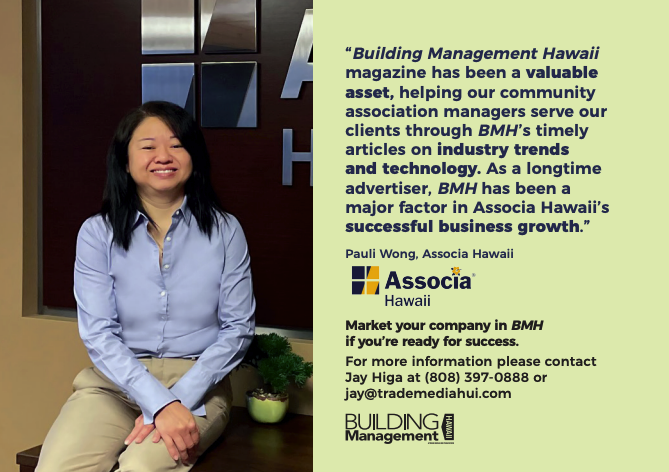Commercial property trends

Have you seen your association’s latest insurance renewal?
Chances are, your insurance program has seen significant premium increases in recent years. If you ask your insurance agent the reason why, the response you will likely receive is due to the “hard insurance market.”
We are in the middle of a hard insurance market, characterized by rising premiums and less insurers writing coverage for the increased demand. Commercial property coverage, mandated by Hawaii Revised Statutes 514B, is an integral part of most associations’ insurance programs and generally represents the biggest chunk of the overall insurance premium.
Let us consider two main drivers of the hard commercial property insurance marketplace—reinsurance and losses—and what your association can do to best be prepared for them.
Reinsurance
The National Association of Insurance Commissioners refers to reinsurance as “insurance for insurance companies.” Some of the benefits of reinsurance include (1) expanded capacity, (2) spread of risk and (3) catastrophe protection.
Reinsurance is the backbone of insurance: it enables insurers to transfer and spread the risk of the losses they write to reinsurers. This allows insurers to effectively manage risk and the amount of capital that they hold to support those risks. In short, reinsurance supports stability and growth for insurers.
Munich Re, one of the world’s leading providers of reinsurance, reported worldwide natural disasters in 2022 resulted in insured losses of roughly $120 billion. Of the $120 billion in insured losses, Hurricane Ian alone amounted to over $60 billion in insured losses. In the aftermath of Hurricane Ian, reinsurers reduced hurricane limits on policies and tightened underwriting guidelines to be more selective of what they will write.
Some of you may be thinking: “Hurricane Ian caused devastation in Florida. What does that have to do with us here in Hawaii?”
Three of the largest admitted insurers for condominium associations — First Insurance Company of Hawaii, DB Insurance Company and Allianz/Fireman’s Fund Insurance Company — are required to adhere to the state’s regulatory requirements, and therefore must purchase and maintain reinsurance.
Globally, the cost of reinsurance has increased, so the cost of doing business for these insurers has also gone up. Insurers are increasing premiums to stabilize their books of business and remain solvent to pay their claims.
HRS 514B mandates full insurable replacement costs for condominium associations. Since some insurers are no longer offering full hurricane limits, associations will need to obtain layered hurricane coverage to comply with the statute and unit owners’ mortgage requirements.
This type of layered hurricane policy will have much higher premiums.
Losses
Another driver of the hard market is losses. Many condominium buildings in Hawaii are now 40 years old or older. Buildings that have deferred maintenance and have not replaced aging components are more likely to experience frequent and severe losses.
Associations with a pattern of frequent or severe losses can be non-renewed out of the admitted market and will have no choice but to turn to the non-admitted market.
Non-admitted insurers tend to have the reputation of being the “insurers of last resort”—they can insure “anything and everything,” but at a price. They are not under the regulation of the Hawaii Insurance Division, do not have to file rates and often charge exponentially higher premiums than admitted insurers.
Once an association is in the non-admitted market, getting back into the admitted market may be difficult, though not impossible.
What can we do to prepare?
Despite systemic risks affecting the insurance industry, including natural disasters, reduced reinsurer capacity and inflation, associations can take immediate action to be prepared and manage expectations for the continued hardening of the market.
Inflation in the U.S. hit a 40-year high in 2022. With the higher cost of construction materials and labor, it may be prudent for associations to review and adjust replacement cost valuations for their buildings to ensure they accurately reflect full replacement cost. This will prevent premium increases due to underinsurance, ensure adequate property coverage when it comes to a loss and avoid co-insurance penalties.
If your association is at risk of being non-renewed from the admitted market, some insurers may be willing to renew under certain conditions. This may be in the form of higher deductibles or premium increases. Insurers also like to see associations implement preventative measures to reduce losses.
Besides regular building maintenance, one initiative condominium associations may consider is a high-risk components inspection, as described in HRS 514B-138. If your association is currently in the non-admitted market with a good loss history, along with the presence of loss-mitigating features in your building like fire sprinklers and central fire alarms, you may qualify for coverage in the admitted market.
Communication with your insurance agent is key to survival in this market. Work with one who has access to all the markets and make sure your agent starts these conversations as early as possible. Your agent should provide you with accurate and unbiased information so your association can make educated decisions when it comes to insurance carriers and policy coverage.
At the end of the day, it is difficult to predict when the market will recover. However, your association can take an active role now in preventing losses, which is key to survival and will help keep your premiums at a reasonable level.
Shane Choi is an account executive at Atlas Insurance Agency. He holds Chartered Property Casualty Underwriter (CPCU), Associate in Insurance (AINS) and Associate in National Flood Insurance (ANFI) designations. Reach him at (808) 533-8637, atlasinsurance.com

